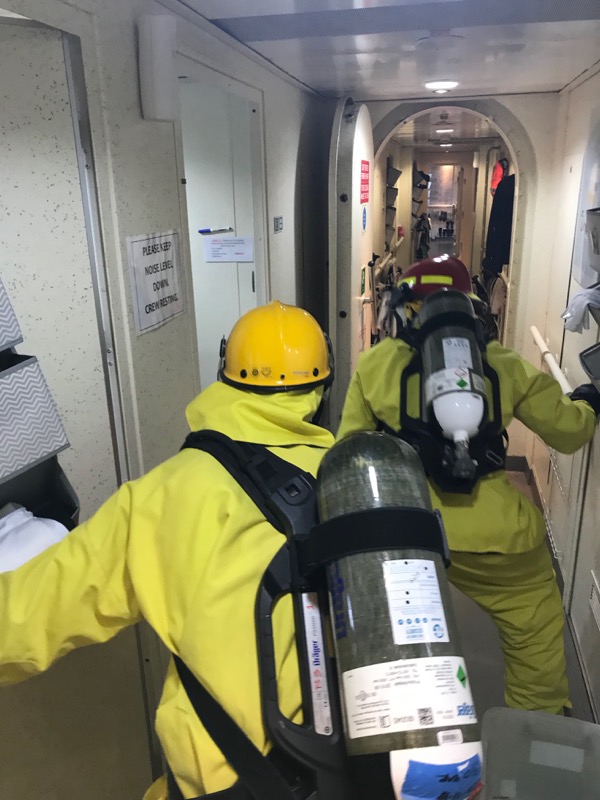Emergency training and drills - nailing the enclosed space rescue
Mark Robinson looks at the requirements for training in enclosed space entry and rescue drills……
Mark Robinson, Master Mariner and Principal Surveyor of Mark Robinson Maritime Consultants looks at the requirements for training in enclosed space entry and rescue drills.
As Marshall Island Flag Surveyors MRMC have carried out a number of these drills recently during annual Flag state compliance verifications and have found this is an oft overlooked area that should be given dedicated practice time, Mark says.
SOLAS regulation 19, section 3.3 requires that ‘Crew members with enclosed space entry or rescue responsibilities shall participate in an enclosed space entry and rescue drill to be held on board the ship at least once every two months.’
We have recently encountered a number of yachts that do not list this as a planned exercise within their mandated annual drill matrix. This may be because, as unlike the shipping fraternity, there are few spaces that are entered into where there may be oxygen-deficient, oxygen-enriched, flammable and/or toxic atmospheres.
Resolution A.1050(27) provides excellent recommendations on how to deal with, be prepared for and safely execute entry and rescuing persons from an enclosed space, remembering that adjacent spaces can be just as dangerous.
An Enclosed space means a space which has any of the following characteristics:
1. limited openings for entry and exit;
2. inadequate ventilation; and
3. is not designed for continuous worker occupancy;
During our Flag state compliance verifications, we are duty bound to witness any number of pre-determined drills to ascertain the competence of the crew and officers. Over the last few weeks we have requested that the yacht demonstrate entry and rescue from an enclosed space, taking into account yachts have limited openings for entry and exit due to design.
For exercise purposes we also require that the space (a crew cabin usually) will be depleted of oxygen and therefore testing the crew’s competence and requirement for atmospheric analysis, the option of donning breathing apparatus, and removing the casualty to a safe place for assessment and treatment. This is then escalated to a medevac scenario so as to further remove the crew member out onto the aft deck for transport ashore/or other means of removal from the yacht.
A number of commonalities were encountered when this scenario was exercised, and we thought we might share these so as to hone your crew and officer’s response to such an incident.
• An appropriately calibrated atmospheric testing device was not available
• Enclosed space entry permit was not available or completed (for rescue)
• Rescue equipment for evacuation was not available or if available, not fully conversant with its operation or function
• Over reliance on ‘paid for’ medical subscription services (doctor on the telephone)
As part of any initial risk assessment, certain scenarios need to be defined, equipment identified, and mitigation measures adopted. Through this process, a standing enclosed space entry permit can be published and entered into the yachts safety management system.
Clearly, one of the most important pieces of equipment would be an atmospheric testing device, with instructions on how to calibrate it (or send ashore for calibration). Its use, parameters and settings must be thoroughly understood by the competent person defined as a ‘person with sufficient theoretical knowledge and practical experience to make an informed assessment of the likelihood of a dangerous atmosphere being present or subsequently arising in the space’.
To effectively remove a casualty from an enclosed space (and we have to assume that the casualty is unable to do this themselves) a stretcher should be available. There are number of units for sale on the market, each having their own specific operation for securing the casualty in a safe manner. This should be drilled in slow time, using a willing participant, so that when the unit has to be used in earnest, the designated crew for dealing with an evacuation is fully conversant with its particular modes of operation/securing and transportation characteristics.
Once the casualty is removed from the space to clean air, a full medical assessment may be undertaken. In some scenarios we have set, the casualty is suffering from a compound fracture. This is clearly a very painful experience and after initial assessment, the casualty will require pain relief, generally administering morphine. To undertake this, the person in charge of medical care on board may well require the assistance of a doctor. This is generally achieved by contacting the nominated subscription service – there are many companies that offer this service for a fee. We have noted that on two occasions, where the medical company has been contacted, a doctor was not available to speak for over 10 minutes the first time, and well over 15 minutes the second; a long time to wait to get the advice on how much and where to administer the morphine injection!
Another option to consider would be a TMAS or Telemedical Maritime Assistance Service – these have been around for many years and provide free immediate medical assistance via the telephone, MRCC or email depending on the location of the yacht. Any monetary donations to this service is voluntary.
Be safe; be compliant!
NEW: Sign up for SuperyachtNewsweek!
Get the latest weekly news, in-depth reports, intelligence, and strategic insights, delivered directly from The Superyacht Group's editors and market analysts.
Stay at the forefront of the superyacht industry with SuperyachtNewsweek
Click here to become part of The Superyacht Group community, and join us in our mission to make this industry accessible to all, and prosperous for the long-term. We are offering access to the superyacht industry’s most comprehensive and longstanding archive of business-critical information, as well as a comprehensive, real-time superyacht fleet database, for just £10 per month, because we are One Industry with One Mission. Sign up here.
Related news

Crew welfare issues
Crew were surveyed about welfare issues, identifying key areas where the industry could improve crew well-being
Crew
Related news
Crew welfare issues
6 years ago
NEW: Sign up for
SuperyachtNewsweek!
Get the latest weekly news, in-depth reports, intelligence, and strategic insights, delivered directly from The Superyacht Group's editors and market analysts.
Stay at the forefront of the superyacht industry with SuperyachtNewsweek




